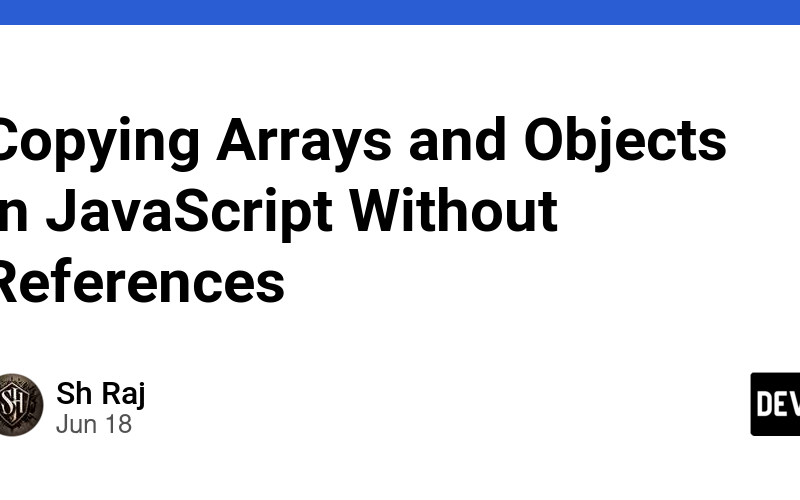Comprehensive Guide to Copying Arrays and Objects in JavaScript Without References
In JavaScript, copying arrays and objects can be tricky due to the nature of references. When you assign an array or object to a new variable, you’re actually assigning a reference to the original data, not a copy. This means that changes to the new variable affect the original data. To avoid this, you need to create a true copy of the array or object. Here’s a detailed guide on how to do this using various methods.
Copying Arrays
1. Using the Spread Operator
The spread operator (...) is a concise way to create a shallow copy of an array.
const originalArray = [1, 2, 3];
const copiedArray = [...originalArray];
2. Using Array.prototype.slice
The slice method can be used to create a shallow copy of an array.
const originalArray = [1, 2, 3];
const copiedArray = originalArray.slice();
3. Using Array.from
The Array.from method creates a new, shallow-copied array from an array-like or iterable object.
const originalArray = [1, 2, 3];
const copiedArray = Array.from(originalArray);
4. Using concat Method
Using the concat method with an empty array also creates a shallow copy.
const originalArray = [1, 2, 3];
const copiedArray = [].concat(originalArray);
Copying Objects
1. Using the Spread Operator
The spread operator can also be used to create a shallow copy of an object.
const originalObject = { a: 1, b: 2 };
const copiedObject = { ...originalObject };
2. Using Object.assign
The Object.assign method copies all enumerable own properties from one or more source objects to a target object.
const originalObject = { a: 1, b: 2 };
const copiedObject = Object.assign({}, originalObject);
3. Using JSON.parse and JSON.stringify
For a deep copy, where nested objects and arrays are also copied, you can use JSON.parse and JSON.stringify. This method does not work well with functions and undefined values.
const originalObject = { a: 1, b: { c: 2 } };
const copiedObject = JSON.parse(JSON.stringify(originalObject));
Deep Copying with Custom Functions
For more complex objects, including those with nested structures, dates, and functions, you might need a custom deep copy function.
1. Recursive Function for Deep Copy
Here’s a basic recursive function to perform a deep copy of an object.
function deepCopy(obj) {
if (obj === null || typeof obj !== 'object') return obj;
if (Array.isArray(obj)) {
const arrCopy = [];
for (let i = 0; i < obj.length; i++) {
arrCopy[i] = deepCopy(obj[i]);
}
return arrCopy;
}
const objCopy = {};
for (const key in obj) {
if (obj.hasOwnProperty(key)) {
objCopy[key] = deepCopy(obj[key]);
}
}
return objCopy;
}
const originalObject = { a: 1, b: { c: 2 } };
const copiedObject = deepCopy(originalObject);
Libraries for Deep Copying
Several libraries provide robust and efficient deep copy functionality, handling edge cases and complex data structures.
1. Lodash
Lodash is a popular utility library that includes a cloneDeep function for deep copying.
const _ = require('lodash');
const originalObject = { a: 1, b: { c: 2 } };
const copiedObject = _.cloneDeep(originalObject);
2. DeepClone
The deepClone library is specifically designed for deep copying objects.
const deepClone = require('deepClone');
const originalObject = { a: 1, b: { c: 2 } };
const copiedObject = deepClone(originalObject);
Conclusion
Copying arrays and objects in JavaScript without maintaining references is crucial for preventing unintended side effects. For simple, shallow copies, the spread operator and methods like slice, Array.from, and Object.assign are effective. For deep copies, JSON.parse with JSON.stringify works for many cases, but custom functions or libraries like Lodash are often necessary for complex structures. By understanding and using these methods, you can ensure your data manipulation is both efficient and safe.
Source link
lol

